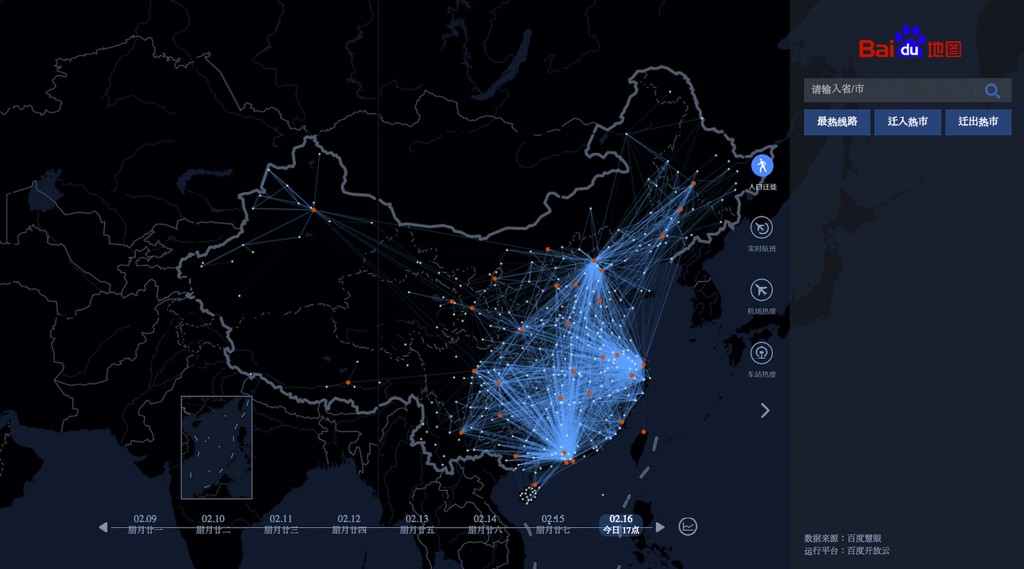- California Assembly OKs highest minimum wage in nation
- S. Korea unveils first graphic cigarette warnings
- US joins with South Korea, Japan in bid to deter North Korea
- LPGA golfer Chun In-gee finally back in action
- S. Korea won’t be top seed in final World Cup qualification round
- US men’s soccer misses 2nd straight Olympics
- US back on track in qualifying with 4-0 win over Guatemala
- High-intensity workout injuries spawn cottage industry
- CDC expands range of Zika mosquitoes into parts of Northeast
- Who knew? ‘The Walking Dead’ is helping families connect
‘Heat map’ captures massive Chinese New Year migration
BEIJING (AP) — This map of China’s Lunar New Year travel tells a story of massive migration home from the big city.

In this image made on Monday, Feb. 16, 2015 from an interactive graphic from Baidu, the Chinese Internet portal, lines tracing the trips of individual travelers provide a “heat map” of the massive migration home from the big cities ahead of China’s Lunar New Year. The interactive graphic shows the brightest spokes emanating from eastern employment hubs Beijing, Shanghai and the southern nexus of Shenzhen, Guangzhou and Dongguan. The lines are drawn from the locations of smartphones. (AP Photo/Baidu)
The interactive, updating graphic posted online by the Chinese Internet portal Baidu shows a “heat map” of lines tracing the trips of individual travelers. The brightest spokes emanate from eastern employment hubs Beijing, Shanghai and the southern nexus of Shenzhen, Guangzhou and Dongguan.
About 80 million people were traveling on Monday alone, mostly by road, according to government estimates. Baidu was able to illustrate many of those journeys thanks to the 350 million active users of its smartphone map and other apps that use location positioning.
If someone uses a Baidu app in Beijing in the morning, then pings from the southwestern city of Kunming in the evening, a new trip will be registered and a straight line added from Beijing to Kunming.
Lines glow white-hot during the biggest travel days of the holiday, which officially runs from Wednesday through Feb. 24 but unofficially includes many days on either end. The period of heightened travel is considered 40 days long.
“You’re basically looking at the serious intensity of travel in this holiday. It’s not just the world’s biggest human migration, it’s the biggest mammalian migration,” Baidu spokesman Kaiser Kuo said. “It’s a sight to behold. It’s quite miraculous that nothing goes terribly wrong.”
The Baidu Migration interactive also includes data for individual cities, airports and train stations, and could help transportation officials plan future seasons, Kuo said.
If he used Baidu apps, 28-year-old Li Shengtao would have contributed to the Baidu interactive when he departed by train from Shanghai where he works as an interior designer for his annual, 1,100-kilometer journey to his northern hometown of Shijiazhuang.
“Even if you don’t manage to buy a ticket you have to get home somehow,” Li said. “That’s the tradition of us northern Chinese.”
The interactive has been employed for more than details on holiday travel. Last Lunar New Year season, some media outlets suggested, rather dubiously, that many of the bright lines on the map emanating from the city of Dongguan were prostitutes fleeing a crackdown there.
















kelly
November 24, 2017 at 11:23 AM
Very nice and always successful.
This is a very good article.
I’m waiting for you the other article.
togel online
leticia
January 6, 2018 at 2:48 AM
domino qiu qiu